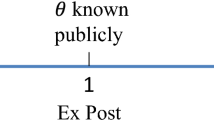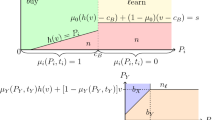Abstract
We study how the manufacturer and the supplier collaborate under various pricing and contracting scenarios. We characterize two downstream pricing strategies: (a) where the manufacturer announces the market price before the quality is determined, and (b) where the manufacturer decides the market price after the quality is determined. We also study three different contracting structures: (a) effort levels are both contractible and verifiable, (b) revenue sharing agreement between manufacturer and supplier, and (c) effort dependent contract when effort levels are verifiable but not contractible. We determine under which conditions the manufacturer should implement each of the scenarios.





Similar content being viewed by others
Notes
Please note that if the manufacturer can observe, verify and subsequently enforce the required level of supplier’s efforts in the contract term, then it is termed as contractible effort. It is also possible that the efforts may be non-contractible because they are difficult to measure and verify to a third party (for example, a court). Even if the effort levels are observable and can be measured, both players have to “prove” their claims to the third party (Kaya and Özer 2009). Moreover, in some settings, the effort levels can be made verifiable to the third party by investing in a reporting/monitoring system (Bhattacharya et al. 2013; Demirezen et al. 2016).
In \(<\phi ,w,L>\) contract, the upfront pricing scenario is always dominant to the postponed pricing. Hence, only the upfront pricing scenario is drawn in Fig. 3b.
In \(<r,w,L>\) contract, the manufacturer’s profit is the same under both pricing scenarios.
References
Awasthy, P., & Hazra, J. (2020). Collaboration under outcome-based contracts for information technology services. European Journal of Operational Research, 286(1), 350–359.
Baiman, S., Fischer, P. E., & Rajan, M. V. (2001). Performance measurement and design in supply chains. Management Science, 47(1), 173–188.
Balachandran, K. R., & Radhakrishnan, S. (2005). Quality implications of warranties in a supply chain. Management Science, 51(8), 1266–1277.
Banker, R. D., Khosla, I., & Sinha, K. K. (1998). Quality and competition. Management Science, 44(9), 1179–1192.
Basu, A., & Bhaskaran, S. (2018). An economic analysis of customer co-design. Information Systems Research, 29(4), 787–786.
Bernstein, F., & Kök, A. G. (2009). Dynamic cost reduction through process improvement in assembly networks. Management Science, 55(4), 552–567.
Bhaskaran, S. R., & Krishnan, V. (2009). Effort, revenue, and cost sharing mechanisms for collaborative new product development. Management Science, 55(7), 1152–1169.
Bhattacharya, S., Gupta, A., & Hasija, S. (2013). Joint product improvement by client and customer support center: The role of gain-share contracts in coordination. Information Systems Research, 25(1), 137–151.
Bhattacharyya, S., & Lafontaine, F. (1995). Double-sided moral hazard and the nature of share contracts. The Rand Journal of Economics, 26(4), 761–781.
Cachon, G. P. (2003). Supply chain coordination with contracts. Handbooks in Operations Research and Management Science, 11, 227–339.
Chao, G. H., Iravani, S. M., & Savaskan, R. C. (2009). Quality improvement incentives and product recall cost sharing contracts. Management Science, 55(7), 1122–1138.
Chen, J., Liang, L., & Yang, F. (2015). Cooperative quality investment in outsourcing. International Journal of Production Economics, 162, 174–191.
Corbett, C. J., & DeCroix, G. A. (2001). Shared-savings contracts for indirect materials in supply chains: Channel profits and environmental impacts. Management Science, 47(7), 881–893.
Corbett, C. J., DeCroix, G. A., & Ha, A. Y. (2005). Optimal shared-savings contracts in supply chains: Linear contracts and double moral hazard. European Journal of Operational Research, 163(3), 653–667.
Demirezen, E. M., Kumar, S., & Shetty, B. (2016). Managing co-creation in information technology projects: A differential games approach. Information Systems Research, 27(3), 517–537.
Dey, D., Fan, M., & Zhang, C. (2010). Design and analysis of contracts for software outsourcing. Information Systems Research, 21(1), 93–114.
Dong, Y., Xu, K., Xu, Y., & Wan, X. (2016). Quality management in multi-level supply chains with outsourced manufacturing. Production and Operations Management, 25(2), 290–305.
El Ouardighi, F., & Shniderman, M. (2019). Supplier’s opportunistic behavior and the quality-efficiency tradeoff with conventional supply chain contracts. Journal of the Operational Research Society, 70(11), 1915–1937.
Foster, S. T. (2008). Towards an understanding of supply chain quality management. Journal of Operations Management, 26(4), 461–467.
Fudenberg, D., & Tirole, J. (1991). Game theory. MIT Press.
Gilbert, S. M., & Cvsa, V. (2003). Strategic commitment to price to stimulate downstream innovation in a supply chain. European Journal of Operational Research, 150(3), 617–639.
Gopal, A., Sivaramakrishnan, K., Krishnan, M. S., & Mukhopadhyay, T. (2003). Contracts in offshore software development: An empirical analysis. Management Science, 49(12), 1671–1683.
Gurnani, H., Erkoc, M., & Luo, Y. (2007). Impact of product pricing and timing of investment decisions on supply chain co-opetition. European Journal of Operational Research, 180(1), 228–248.
Iida, T. (2012). Coordination of cooperative cost-reduction efforts in a supply chain partnership. European Journal of Operational Research, 222(2), 180–190.
Iyer, A. V., Schwarz, L. B., & Zenios, S. A. (2005). A principal-agent model for product specification and production. Management Science, 51(1), 106–119.
Jain, T., & Hazra, J. (2017). SATTVA eTECH: Challenges in embedded new product development. Harvard Business Review Publishing (Case number IMB609-PDF- ENG).
Karaer, Ö., & Erhun, F. (2015). Quality and entry deterrence. European Journal of Operational Research, 240(1), 292–303.
Kaya, M., & Özer, Ö. (2009). Quality risk in outsourcing: Noncontractible product quality and private quality cost information. Naval Research Logistics (NRL), 56(7), 669–685.
Kim, S. H., & Netessine, S. (2013). Collaborative cost reduction and component procurement under information asymmetry. Management Science, 59(1), 189–206.
Kim, S. K., & Wang, S. (1998). Linear contracts and the double moral-hazard. Journal of Economic Theory, 82(2), 342–378.
Laffont, J. J., & Martimort, D. (2009). The theory of incentives: The principal-agent model. Princeton University Press.
Laffont, J. J., & Tirole, J. (1993). A theory of incentives in procurement and regulation. MIT Press.
Li, C. (2013). Sourcing for supplier effort and competition: Design of the supply base and pricing mechanism. Management Science, 59(6), 1389–1406.
Liker, J. K., & Choi, T. Y. (2004). Building deep supplier relationships. Harvard Business Review, 82(12), 104–113.
Moussawi-Haidar, L., & Çömez-Dolgan, N. (2017). Percentage rent contracts between co-stores. European Journal of Operational Research, 258(3), 912–925.
Özer, Ö., & Raz, G. (2011). Supply chain sourcing under asymmetric information. Production and Operations Management, 20(1), 92–115.
Plambeck, E. L., & Taylor, T. A. (2007). Implications of renegotiation for optimal contract flexibility and investment. Management Science, 53(12), 1872–1886.
Pun, H. (2015). The more the better? optimal degree of supply-chain cooperation between competitors. Journal of the Operational Research Society, 66(12), 2092–2101.
Roels, G., Karmarkar, U. S., & Carr, S. (2010). Contracting for collaborative services. Management Science, 56(5), 849–863.
Satariano, A. (2013). Apple \$10.5b on robots to lasers shores up supply chain. https://www.bloomberg.com/news/articles/2013-11-13/apple-s-10-5b-on-robots-to-lasers-shores-up-supply-chain.
Wang, J., & Shin, H. (2015). The impact of contracts and competition on upstream innovation in a supply chain. Production and Operations Management, 24(1), 134–146.
won Kim, B., & El Ouardigh, F. (2007). Supplier–manufacturer collaboration on new product development. In Advances in dynamic game theory (pp. 527–545). Springer.
Wong, K. P. (2012). Optimal two-part pricing under cost uncertainty. Managerial and Decision Economics, 33(1), 39–46.
Wong, K. P. (2014). Optimal two-part pricing under demand uncertainty. Managerial and Decision Economics, 35(6), 423–432.
Xiao, T., Xia, Y., & Zhang, G. P. (2014). Strategic outsourcing decisions for manufacturers competing on product quality. IIE Transactions, 46(4), 313–329.
Xie, G., Yue, W., Wang, S., & Lai, K. K. (2011). Quality investment and price decision in a risk-averse supply chain. European Journal of Operational Research, 214(2), 403–410.
Yan, X., Zhao, H., & Tang, K. (2015). Requirement or promise? An analysis of the first-mover advantage in quality contracting. Production and Operations Management, 24(6), 917–933.
Yildiz, M. (2012). Economic applications of game theory (lecture notes), Mit open courseware. https://ocw.mit.edu/courses/economics/14-12-economic-applications-of-game-theory-fall-2012/lecture-notes/MIT14_12F12_chapter9.pdf.
Zhu, K., Zhang, R. Q., & Tsung, F. (2007). Pushing quality improvement along supply chains. Management Science, 53(3), 421–436.
Author information
Authors and Affiliations
Corresponding author
Additional information
Publisher's Note
Springer Nature remains neutral with regard to jurisdictional claims in published maps and institutional affiliations.
Supplementary Information
Below is the link to the electronic supplementary material.
Rights and permissions
About this article
Cite this article
Mandal, P., Jain, T. & Chakraborty, A. Quality collaboration contracts under product pricing strategies. Ann Oper Res 302, 231–264 (2021). https://doi.org/10.1007/s10479-021-04060-w
Accepted:
Published:
Issue Date:
DOI: https://doi.org/10.1007/s10479-021-04060-w




